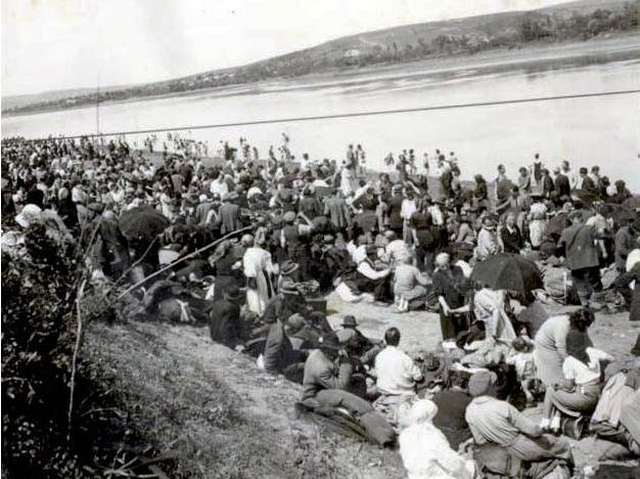The Cardboard Boats
An outlook at one of the myths revolving around the Romania genocide during World War II

Steliu Lambru, 03.02.2014, 13:14
On June 1, 1942, Marshal Ion Antonescu started the deportation of the Rroma, Romania’s gypsy population, sending them to labor camps in Transdnestr. The number of people involved varies in estimates between 25,000 and 38,000, of which around 1,500 survived the war. Living and working conditions were dire, and the terrible death toll was mainly due to dysentery and typhoid fever. In spite of protests from the king Mihai I and Queen Mother Elena, the Antonescu government neither set the Rroma free nor improved their living conditions. The official line was that nomadic Rroma were a social peril.
This tragedy, however, gave birth to myths of its own, such as the one of the cardboard boats. According to that story, the Rroma were put on dingy boats made of cardboard and sent across the river Bug. The shabby boats fell apart in the water, sending people to their deaths. Adrian Nicolae Furtuna spoke to us about his research into this myth as head of investigative research.
“There are no archive documents mentioning this episode, and, of all the survivors we and others interviewed, none mention this cardboard boat incident, as an eye-witness or otherwise. The story goes that the Rroma were put on a cardboard boat, then left to drift on the river Bug until the boat got wet and just sank along with the people inside. This story has a drop of irony and hilarity to it, if we were to compare the way in which Jews were dying in Transdnestr. In this cardboard boat case, the comparison raises a lot of questions. As far as our research has managed to reveal, this myth originates in the sinking of the ship Struma, which occurred in February 1942. The Rroma looked at this event and reformulated it in line with their culture. This social representation was encouraged by several elements. One of them was Marshal Antonescu’s initial plan to deport the Rroma by waterways. Before being deported, they were identified, and the gendarmes went house to house to tell them who was going to be deported. A social representation is an entire chain. There are also documents showing how many Rroma and how many horse-drawn carts were going to arrive in every city harbor on the Danube. The Rroma thought they were going to be drowned, as the Jews had been.”
Young Rroma nowadays are barely aware of the porajmos, the Romani holocaust. Adrian Nicolae Furtuna spoke to us about generational memory works, and how other recollections of tragedies become myth.
“We try to go beyond the myth, trying to see what this memory comprised. Most young Rroma have no hard data on the deportation to Transdnestr. They don’t know the year when it happened, don’t know key words, such as Bug or Transdnestr, but they know the cardboard boat story. They associate it with the Holocaust in the West. This happens because the Jewish Holocaust has received much wider media coverage. Many of the young Rroma say that the deportees were gassed in Transdnestr, which did not happen. However, we wanted to see how history gets conveyed from one generation to the next. In the case of the Rroma, this process is different, because the Rroma left behind mostly myths and tales. Rudar Romani, whose traditional occupation was woodworking, claimed that they were not deported because the Royal House used wooden spoons and wooden bathtubs. Of course some of the Rudar have been deported, but the Rudar villages that were not displaced claimed that this happened because they manufactured goods for the Royal House. Here is yet another myth that is very telling when it comes to traditional Rroma culture.”
The cardboard boat myth has the function of keeping alive the memory of the Rroma genocide.
Vm Track: “I was interviewing a 90 year-old lady. She hadn’t been deported, but at her age she could give me loads of hands-on information about the general situation. Her grandson walked in on the interview, and told her to tell the story of the Antonescu’s cardboard boats. And he was laughing as he said it. When I go into communities of Rroma, sometimes I go with a camera team, who tell the people that we are looking for survivors. And they just laugh and tell each other ‘Why don’t you invite these people over, you’ve been there, at the Bug.’ This shows you the way in which the Rroma see the event, and the historical root of the deportation is its social criteria. Most of the Rroma deported had not fixed residence, no fixed job, it was a social cleansing. This in turn caused a sort of ridicule: ‘so my neighbor who doesn’t have a job gets deported and I don’t”. There was no solidarity among people, and the function of the myth of cardboard boats is one of memory conservation. It is an ironic sort of conservation, however, different from the way in which a man from a western culture would behave when referring to such a tragic event as deportation.”
Even if the cardboard boat episode is merely a historical artifact, contributing to the shaping of Rroma identity, the wider genocide cannot be denied.






























